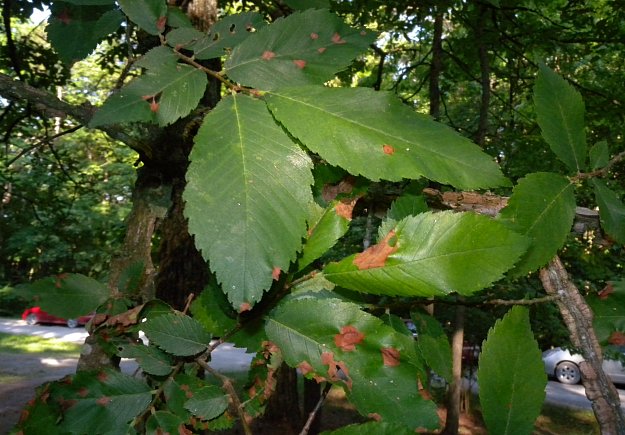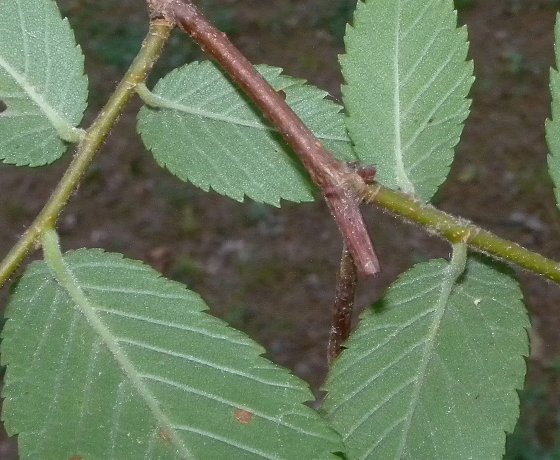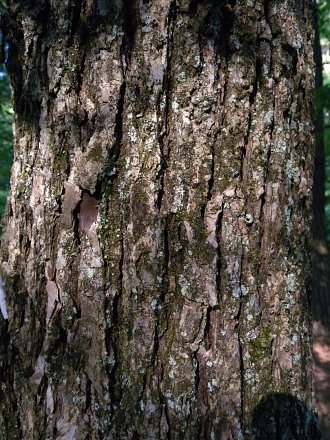
The flowers of Winged Elm (Ulmus alata) are perfect and about 6 mm. (¼") in length, consisting of a light green calyx with 5 rounded lobes (but sometimes up to 9 lobes), 5 stamens with reddish anthers (but sometimes up to 9 stamens), and a flattened green ovary with a pair of stigmata. These flowers are produced from short spur twigs in small clusters up to 1" long; there are 4-10 flowers per cluster. The pedicels of the flowers are slender. The blooming period occurs from late winter to early spring for 1-2 weeks before the vernal leaves develop. Afterwards, these flowers are replaced by flattened samaras that become mature during mid-spring before the vernal leaves fully develop. Mature samaras are about 7-10 mm. long and about one-half as much across; they are typically reddish brown with pubescent sides and strongly ciliate margins. At the tip of each samara, there is a pair of narrow curved claws. Each samara contains a single small nutlet in its center. The samaras are dispersed by the wind.

Cultivation: This tree prefers full to partial sun and moist to dry conditions. Different kinds of soil are tolerated, including those that contain, loam, clay, sand, or rocky material. The fertility of the soil and moisture regime have a strong impact on the ultimate size of this tree. It is hardy to at least Zone 6. Like other native elms, it has some vulnerability to Dutch Elm disease.
Range & Habitat: The native Winged Elm is fairly common in southern Illinois, while in the rest of the state it is absent (see Distribution Map). Typical habitats include rocky upland woodlands, upland savannas, bluffs, sandstone and limestone glades, abandoned fields, and fence rows. Less often, this tree occurs in moist rocky ravines and canyons. This is a pioneer species of difficult marginal habitats, woodlands that have been subjected to fire, and more developed areas with a history of disturbance.

Faunal Associations: Numerous insects feed on the wood, foliage, plant juices, and other parts of Winged Elm (Ulmus alata) and other elm trees (Ulmus spp.). These species include the larvae of wood-boring beetles, weevils, leaf beetles, larvae of bark beetles, plant bugs, stink bugs, aphids, leafhoppers, treehoppers, mealybugs, walkingsticks, armored scales, larvae of sawflies, larvae of moths (including sphinx moths & giant silk moths), and larvae of the following butterflies: the Mourning Cloak (Nymphalis antiopa), Comma (Polygonia comma), and Question Mark (Polygonia interrogationis). The Insect Table provides a list of these insect feeders. These insects often attract insectivorous songbirds. Other birds feed on the seeds and/or buds of these trees: This includes the Bobwhite Quail, Ruffed Grouse, Wild Turkey, Ring-necked Pheasant, Greater Prairie Chicken, Northern Cardinal, Rose-breasted Grosbeak, Evening Grosbeak, Purple Finch, American Goldfinch, Common Redpoll, Pine Siskin, House Sparrow, Black-capped Chickadee, Carolina Chickadee, Yellow-rumped Warbler, Wood Duck, and former Passenger Pigeon. The Yellow-bellied Sapsucker also feeds on the sap of these trees (Martin et al., 1951/1961; DeVore et al., 2004; Schorger, 1955; DeGraaf, 2002; Schwartz, 1945). Some mammals also use these trees as a source of food: This includes the American Beaver (wood, bark), White-tailed Deer (twigs), Cottontail Rabbit (bark of saplings), Eastern Gray Squirrel (seeds), and Fox Squirrel (seeds, buds, florets); Martin et al. (1951/1961). There are records for some turtles, such as the Smooth Softshell (Apalone mutica) and Ouachita Map Turtle (Graptemys ouachitensis), feeding on fallen samaras or leaves (Ernst et al., 1994). The Eastern Screech Owl and such bats as the Evening Bat, Tricolored Bat, and Eastern Red Bat also use elm trees sometimes as roost trees (Belthoff & Ritchison, 1990; MuÌnzer, 2008; Veilleux et al., 2003; Perry & Thill, 2008; Mager & Nelson, 2001). Various woodpeckers often create cavities in these trees for their nests.

Photographic Location: A parking and picnic area within an upland woodlands in southern Illinois.
Comments: Winged Elm (Ulmus alata) has a distinctive appearance because of its corky-winged twigs and small branches. The only other native elm in Illinois with this characteristic is the Rock Elm (Ulmus thomasii), which is found in the northern half of Illinois. This latter elm can be distinguished from the former tree by its larger leaves and longer petioles. The wood of Winged Elm is relatively heavy, fine-grained, light brown, and difficult to split. However, it is not particularly strong. Such items as furniture, hardwood flooring, boxes, wooden crates, tool handles, and high quality hockey sticks have been made from it. Various fungi feed on the wood of elms (Ulmus spp.), particularly rotting logs, trunks, and stumps. These fungal species include Auricularia mesenterica (Tripe Fungus), Coprinellus micaceus (Glistening Inkcap), Hypsizygus ulmarius (Elm Leech), Pluteus aurantiorugosus (Flame Shield), Rhodotus palmatus (Wrinkled Peach), Rigidoporus ulmarius (Giant Elm Bracket), and Flammulina veluptipes (Velvet Shank). This last fungus is the source of the cultivated "enoki" mushrooms that are sold in supermarkets.